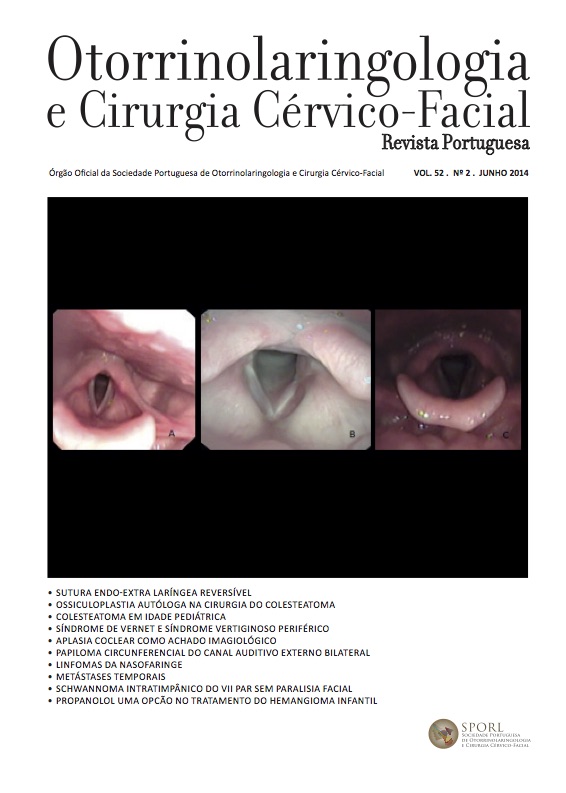Propanolol: Uma opção no tratamento do hemangioma infantil - A propósito de um caso clínico
DOI:
https://doi.org/10.34631/sporl.466Palavras-chave:
hemangioma, propanololResumo
O hemangioma infantil consiste num tumor vascular benigno, sendo considerado o mais frequente na idade pediátrica. Apesar de na maioria dos casos a sua regressão ser espontânea, em cerca de 10% é necessário tratamento médico ou cirúrgico pela sua localização, dimensões ou ocorrência de complicações.
Os autores descrevem o caso clínico de uma doente de 4 anos com hemangioma do lábio superior, previamente tratada com corticoterapia sistémica e Laser PDL, submetida a tratamento médico com propanolol.
O bloqueador β propanolol constitui uma opção eficaz e segura no tratamento do HI com compromisso estético e/ ou complicado. Apesar desta indicação terapêutica não se encontrar ainda definitivamente aprovada, é já considerado como tratamento de 1ª linha, em detrimento da corticoterapia sistémica, face aos excelentes resultados descritos nos últimos anos.
Downloads
Referências
Starkey E, Shahidullah H. Propanolol for infantile hemangiomas: a review. Archives of Disease in Childhood 2011; 96: 890-3.
Drolet BA, Swanson EA, Frien IJ. Infantile hemangioma: an emerging health issue linked to an increased rate of low birth weight infants. Journal of Pediatrics 2008; 153: 712-5
Guia para el Diagnóstico y Terapéutica de los Tumores Vasculares en la Infancia; Sociedad Española de Hematología y Oncología
Pediátricas 2010
Soshana G; Bischoff J. Infantile Hemangioma - Mechanism of drug action on a vascular tumor. Cold Spring Harb Perspective Med 2011. 1:a006460
Chang LC, Haggstrom AN, Drolet BA et al. Growth Cahracteristics of Infantile Hemangiomas: Implications for management. Pediatrics 2008; 122:360-7
Li YC, McCahon E, Rowe NA et al. Successful treatment of infantile hemangioma of the orbit with propanolol. Clinical Experiment
Ophtalmology 2010; 38:554-9
Zimmermann AP, Wiegand S, Werner JA, et al. Propanolol Therapy in Infantile Haemangioma Miller: review of the literature. Internationl Journal of Pediatric Otolaryngology 2010; 74:338-42.
El-Essawy R, Galal R, Abdelbaki S. Nonselective β-blocker propanolol for orbital and periorbital hemangiomas in infants: a new first-line of treatment? Clinical Ophtalmology 2011; 5: 1639-44
Powell J. Update on hemangiomas and vascular malformations. Current Opinion Pediatr 1999; 11(5):457-63
Norman AW, Mizwicki MT, Norman DP: Steroid-hormon rapid actions, membrane receptors and a conformational ensemble model. Nature Review Drug Discovery 2004; 3: 27-41
Léauté-Labrèze C, Dumas de la Roque E, Hubiche T, Boralevi F et al. A propanolol for sever hemangiomas of infancy. New England Journal of Medicine 2008 ; 358(24) :2649-51
Buck M, Pharm D. Oral Propanolol for Hemangiomas of Infancy. Pediatric Pharmacotherapy 2010; 16: number 8
Buckmiller L, Dyamenahalli U, Richter GT. Propanolol for infantile hemangiomas: early experience at a tertiary vascular anomalies center. Laryngoscope 2010; 120:676-81
Li-Q, Yu Y, Bischoff J. Differential expression of CD146 in tissues and endothelial cells derived from infantile haemangioma and normal skin. Journal of Pathology 2003; 201:296-302
Greenberger S, Adini I, Boscolo E, Bischoff J. Targeting NF-kV in Infantile Hemangioma-derived stem cells. New England Journal of Medicine 2010; 362: 1005-13
Sanchez-Carpintero I, Ruiz-Rodriguez R. López-Gutiérrez JC. Propanolol en hemangiomas infantiles: eficacia clínica, riesgos y
recomendaciones. Actas Dermo-Sifiliográficas 2011: 102(10):766-79
Ritter MR, Butschek RA; Friedlander M. Pathogenesis of infantile hemangioma: new molecular and cellular insights. Experience Review Molecular Medicine 2007; 9 (32): 1-19
Haggstrom AN, Drolet BA, Baselga E, Chamlin SL, Garzon MC, et al. Prospective study of infantile hemangioma: clinical characteristics predicting complications and treatment. Pediatrics 2006; 118:882-7
Cushing S, Boucek RJ, Manning SC, Sidbury R, Perkins J. Initial Experience with a multidisciplinary strategy for initiation of propanolol therapy for infantile hemangioma. Otolaryngology- Head and Neck Surgery 2011; 144(1)-78-84






